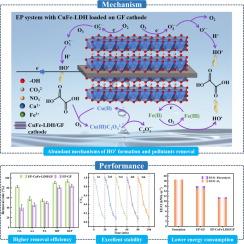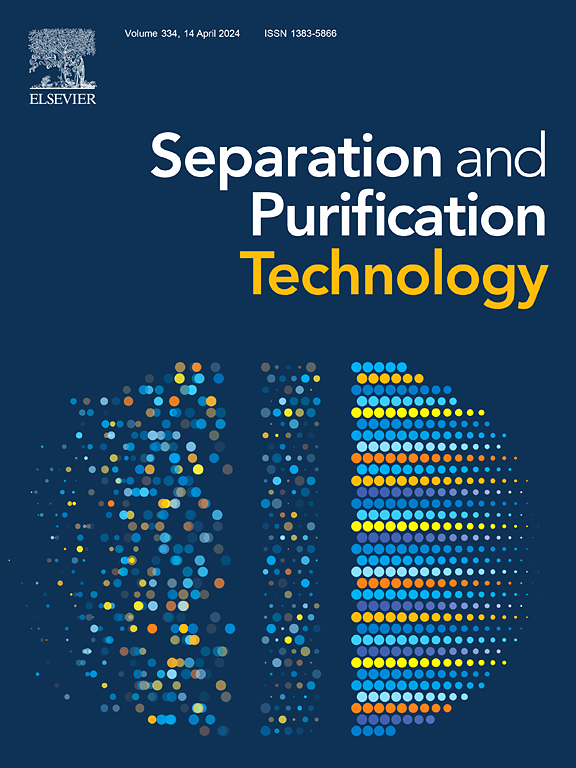Fe-based layered double hydroxides carbon cathode modulates oxygen reduction pathways and HO formation mechanism in electro-peroxone system
IF 8.1
1区 工程技术
Q1 ENGINEERING, CHEMICAL
引用次数: 0
Abstract
Electro-peroxone (EP) is an emerging technology that combines electrochemistry and O3 to remove contaminants. However, conventional carbon cathodes primarily contribute to the synthesis of H2O2 in the system, which may scavenge HO . Herein, a series of Fe-based layered double hydroxides (LDH) was loaded onto graphite felt cathodes to strengthen the removal of organic contaminants. The EP system with CuFe-LDH/GF cathode (EP-CuFe-LDH/GF) demonstrated the highest removal rate (91.2 % within 20 min) of oxalic acid (OA), a typical ozone-resistance substance, approximately twice that of the EP-GF system. HO
. Herein, a series of Fe-based layered double hydroxides (LDH) was loaded onto graphite felt cathodes to strengthen the removal of organic contaminants. The EP system with CuFe-LDH/GF cathode (EP-CuFe-LDH/GF) demonstrated the highest removal rate (91.2 % within 20 min) of oxalic acid (OA), a typical ozone-resistance substance, approximately twice that of the EP-GF system. HO was identified the main reactive species. A new pathway for O2 reduction and the generation of HO
was identified the main reactive species. A new pathway for O2 reduction and the generation of HO was found. The loading of CuFe-LDH altered the reduction pathway of O2 on the GF cathode from 2e− to 1e− or 4e− process. As a result, HO
was found. The loading of CuFe-LDH altered the reduction pathway of O2 on the GF cathode from 2e− to 1e− or 4e− process. As a result, HO was produced by the combination of O3 and O2
was produced by the combination of O3 and O2 − instead of O3 and H2O2, which avoided the quenching of HO
− instead of O3 and H2O2, which avoided the quenching of HO by H2O2 and enhanced the removal of OA. Moreover, the breaking complexation by O3, cathodic O3 reduction and metal-OH catalyzed O3 processes also contributed to the HO
by H2O2 and enhanced the removal of OA. Moreover, the breaking complexation by O3, cathodic O3 reduction and metal-OH catalyzed O3 processes also contributed to the HO formation. Furthermore, the system could efficiently remove OA across a broad pH range of 3.0 to 9.0, addressing the poor performance of conventional EP systems under acidic conditions. Overall, the finding of this significant mechanism advances the understanding of organic pollutants removal and broadens the potential applications of EP system.
formation. Furthermore, the system could efficiently remove OA across a broad pH range of 3.0 to 9.0, addressing the poor performance of conventional EP systems under acidic conditions. Overall, the finding of this significant mechanism advances the understanding of organic pollutants removal and broadens the potential applications of EP system.

求助全文
约1分钟内获得全文
求助全文
来源期刊

Separation and Purification Technology
工程技术-工程:化工
CiteScore
14.00
自引率
12.80%
发文量
2347
审稿时长
43 days
期刊介绍:
Separation and Purification Technology is a premier journal committed to sharing innovative methods for separation and purification in chemical and environmental engineering, encompassing both homogeneous solutions and heterogeneous mixtures. Our scope includes the separation and/or purification of liquids, vapors, and gases, as well as carbon capture and separation techniques. However, it's important to note that methods solely intended for analytical purposes are not within the scope of the journal. Additionally, disciplines such as soil science, polymer science, and metallurgy fall outside the purview of Separation and Purification Technology. Join us in advancing the field of separation and purification methods for sustainable solutions in chemical and environmental engineering.
 求助内容:
求助内容: 应助结果提醒方式:
应助结果提醒方式:


